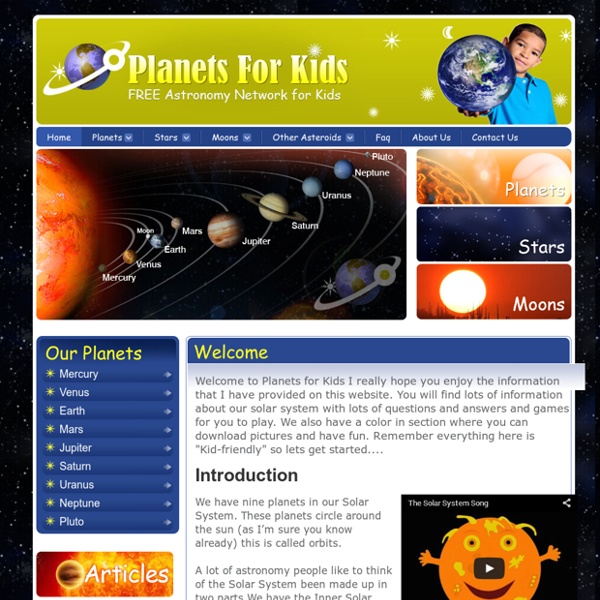



http://www.planetsforkids.org/
Related: tthreadgoldEarth Facts - Planet Earth - Earth For Kids The Earth is unlike every other planet in the Solar System in a number of different ways.It is the only planet that has an atmosphere containing 21 percent oxygen. It is the only planet that has liquid water on its surface. It is the only planet in the solar system that has life. The Earth is the only inner planet (Mercury, Venus, Earth and Mars) to have one large satellite, the Moon. Mars has two very tiny moons. Mercury and Venus have none. The Solar System Our solar neighborhood is an exciting place. The Solar System is full of planets, moons, asteroids, comets, minor planets, and many other exciting objects. Learn about Io, the explosive moon that orbits the planet Jupiter, or explore the gigantic canyons and deserts on Mars. What Is The Solar System? The Solar System is made up of all the planets that orbit our Sun.
dudtbunny's Astronomy for Kids! Earthrise The crew of Apollo 8 sent back this awe-inspiring image of Earth rising over the horizon of the Moon in December 1968Image Courtesy of:NASA If this is your first time here, you may want to visit the Site Information section first. If you are looking for something in particular, you will probably be able to find it either in our Site Index or the Site Map. How Big is the Solar System? Copyright 1989 by Guy Ottewell Universal Workshop PO Box 102 Raynham, MA 02767-0102 Toll Free: 800-533-5083 Fax: 508-967-2702 Email: customerservice@universalworkshop.com This is a classic exercise for visualizing just how BIG our Solar System really is. Both the relative size and spacing of the planets are demonstrated in this outdoor exercise, using a mere peppercorn to represent the size of the Earth. Guy Ottewell has kindly given permission for this electronic presentation of The Thousand-Yard Model; his exercise is presented in its original form, indexed with a few anchors to help you find you way around the large file. We also include a catalog describing several Ottewell publications. Image of the planets courtesy of NASA.
NASA Kids Club Skip to main content NASA Kids Club › Text Only Site Space Racers Watch. Play. 9 children's books about the planets and solar system Sharing is caring - thank you for spreading the word! I often joke to my husband that studying the universe hurts my brain because it is just so incredible to wrap my head around how utterly vast the universe is. It is slightly easier for me to contemplate our solar system. Although our solar system is still very big, it does seem a bit more knowable than our entire universe. In any case, our whole family had a great time to learning about the planets and solar system during our space unit.
MAVEN - Mars Exploration Program NASA Goddard hosted a live Google+ Hangout on Wednesday, Nov. 13 at 4 p.m. EST about MAVEN, NASA's next mission to Mars. Credit: NASA/GSFC MAVEN will examine the upper atmosphere of Mars in unprecedented detail. It's scheduled to launch no earlier than 1:28 p.m. EST Monday, Nov. 18, from Cape Canaveral Air Force Station in Florida. The Solar System Our solar neighborhood is an exciting place. The Solar System is full of planets, moons, asteroids, comets, minor planets, and many other exciting objects. Learn about Io, the explosive moon that orbits the planet Jupiter, or explore the gigantic canyons and deserts on Mars. What Is The Solar System? The Solar System is made up of all the planets that orbit our Sun. In addition to planets, the Solar System also consists of moons, comets, asteroids, minor planets, and dust and gas.
Astronomy For Beginners...Links Heres some astronomy links for you, some of them pages I found useful when I've been looking for information. If you have any good astronomy links or have your own site you would like me to link to you can submit them (although I would appreciate a link in return!). For a list of the very best personal astronomy sites in my opinion have a look at the list of winners of my website award Please remember: I am not responsible for the content of these external sites. National Geographic Society An axis is an invisible line around which an object rotates, or spins. The object can be a tiny particle, smaller than a single atom. Or it could be a star with the mass of a thousand suns. In either case, an object's axis runs through its center of mass, or barycenter. An object's center of mass is a point where an outside force acting on the object acts as if the object were located at just that point—where the object appears "balanced." Earth's center of mass actually varies.